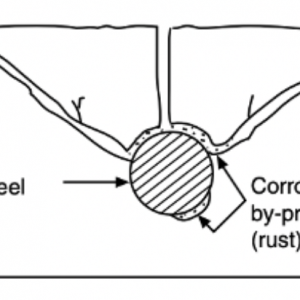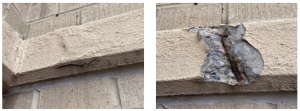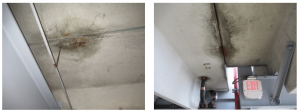Concrete is a versatile material in construction. This common material is utilized for walls, floors, foundations, piers, steps, balconies, roofs, and many other similar structural building components. Concrete requires reinforcement to properly perform in a structural capacity. Most concrete structures contain steel reinforcement. Corrosion of embedded steel reinforcement in concrete may lead to concrete spalling. If left undiagnosed and untreated, concrete spalling may lead to dangerous conditions. There is a benefit to understanding basic causes that lead to concrete spalling and other forms of material failure; once these causes are identified and understood, there are preventative ways to repair the concrete and install protective systems to extend the lifespan.
Why does concrete spalling occur?
When steel corrodes, rust accumulation expands within the embedded concrete. This expansion of the steel creates stresses in the concrete, which can eventually cause cracks and spalling of the concrete that surrounds the steel reinforcement (see Figure 1 below).

Figure 1: Expansion of corroding steel creates tensile stresses in the concrete which can cause concrete spalling.
Concrete fascias and soffits
There are many factors that contribute to concrete spalling— too many to mention in this short article. In the context of building enclosures, some common causes include:
- Inadequate cover: Cover is the distance between the exposed surface of the concrete to the outer surface of the rebar. Deeper covers are typically required in more salt-laden environments. Salt chlorides (in coastal environments) and water (rain) will contribute to steel corrosion and concrete spalling.
- Poor waterproofing: Concrete is inherently porous. Defective or absent waterproofing on horizontal and vertical surfaces will allow water absorption within the concrete and the moisture will typically react with the embedded steel reinforcement; when the steel corrodes, it will expand and displace the concrete which causes cracks and spalls.
What are some tell-tale signs of steel reinforcement corrosion and concrete spalling?
- Cracking: The expansive forces of corroded steel reinforcement may cause concrete to crack. Cracks that are slightly raised from the surface are good indicators of steel corrosion.
- Plating: Depending on the orientation of the steel reinforcement, corroded steel reinforcement may also cause concrete to the plate. Undulation or unevenness on a flat surface may indicate underlying steel corrosion (see Figure 2 below).
- Rust staining: Brown rust byproducts may wash out from cracks and stain the surface of the concrete. This is a good tell-tale sign of underlying corrosion within concrete (see Figure 3 below).

Figure 2: Plating on a concrete eyebrow (left). Breaking out the plated concrete revealed an underlying corroded steel reinforcement (right).

Figure 3: Typical rust staining on the concrete soffit of a parking deck.
Why is this a problem?
While the problem may initially appear to be an aesthetic or cosmetic concern, the concrete system is beginning a process of deterioration, resulting in material failure and loss of structural integrity. Steel reinforcements resist tensile forces in concrete, and the cross-sectional area of each reinforcing bar resists the load. As the steel begins to corrode, the effective cross-sectional area of the bar reduces. Depending on the level of steel corrosion, the structural integrity of the structure may be affected. It’s best to obtain the opinion of a professional engineer to assess this.
In addition, cracked and plated sections of concrete may eventually spall off from the structure, leading to falling debris. Spalled concrete is more of a concern on overhead and vertical surfaces – especially if these are situated directly over pedestrian areas.
What can you do to prevent or remediate it?
- Exterior coatings and waterproofing systems: Various surface-applied coatings and waterproofing membranes such as elastomers, acrylics, aliphatics, PMMAs, etc. can provide feasible protective barriers to prevent water infiltration that will affect steel reinforcement, as well as elongate the lifespan of the concrete structure.
- Cathodic protection: Cathodic protection is a technique used to control the corrosion of metal. In simple terms, a more easily corroded “sacrificial metal” is connected to the steel reinforcement, so that the sacrificial metal corrodes rather than the structure’s steel reinforcement. Qualified professionals best design cathodic protection systems.
- Concrete repairs: Concrete repairs are intended to expose the underlying corroded steel reinforcement. If the extent of corrosion is not severe, corrosion mitigation products may be applied following the removal of all surface rust, down to the sound and clean steel. The steel may be treated with zinc-rich coatings, epoxy, or other similar functioning protective systems. Following the treatment of the steel, concrete repair mortars are typically applied to patch the repair location to infill and replace the deteriorated section.
- Concrete replacement: Sometimes, the steel corrosion on a concrete structure is too severe for treatment, since the extent of partial replacement and in-place repairs may be close to the cost of full replacement. It is common that the cost of a comprehensive repair may exceed the cost of a full replacement. In this case, a full replacement may be a more feasible option.
Concrete spalling may also be indicative of a more serious and costly issue, depending on when the conditions are discovered. There are many factors that contribute to concrete spalling – the most common in the building envelope, which can be attributed to inadequate protection from weathering. In order to protect the exposed concrete on a building structure from water infiltration, qualified building enclosure professionals are well suited to evaluate the conditions and specify best industry practices for necessary repairs and implementing a moisture mitigation program.
